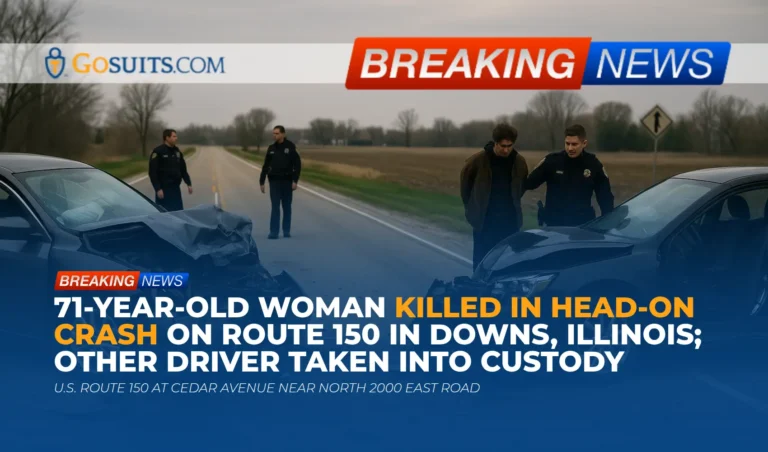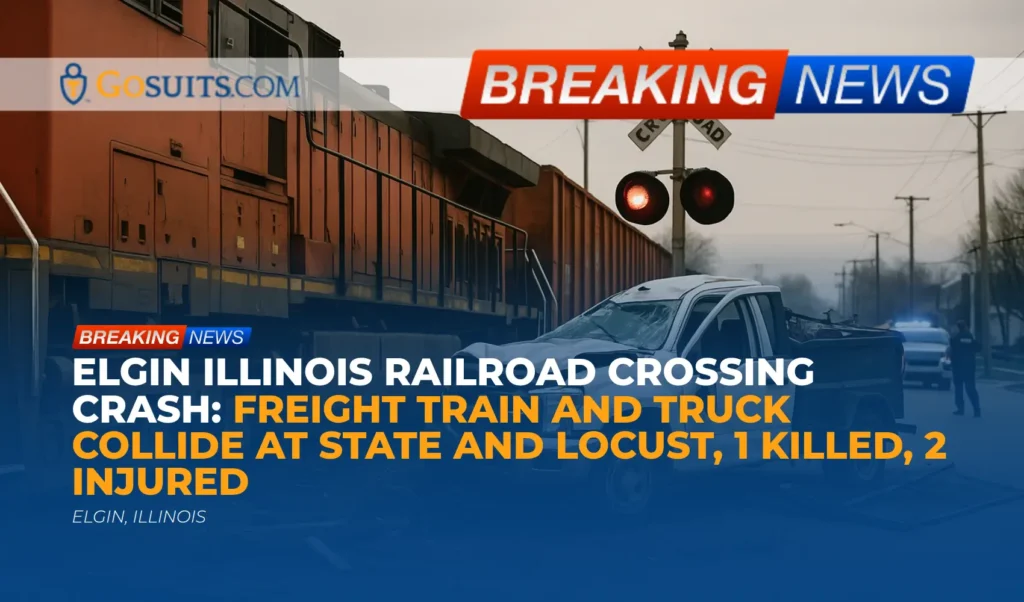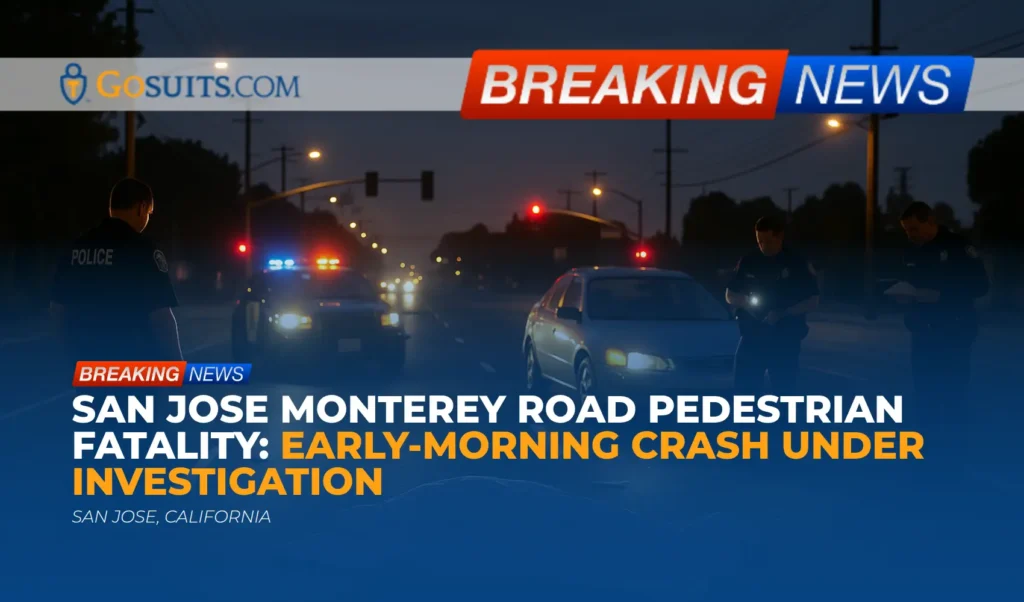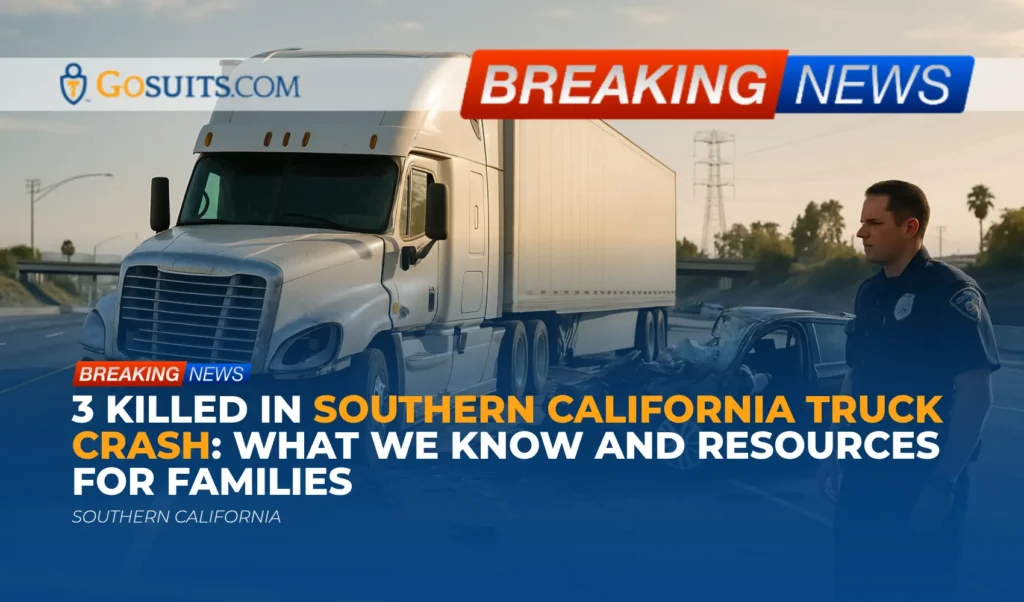- Overview of the Downs, Illinois crash
- What authorities have reported
- Location context: U.S. Route 150 at Cedar Avenue near North 2000 East Road
- Why head-on collisions are so devastating
- Civil liability considerations after a head-on crash in Illinois
- Wrongful death and survival actions in Illinois
- Comparative fault and why details matter
- Evidence to preserve and how families can gather key records
- How to obtain official records in McLean County
- Insurance issues and common pitfalls after a serious crash
- Timelines to keep in mind
- Supportive resources for grieving families
- Commentary from Gosuits Downs, Illinois Personal Injury Attorney
- Why acting promptly matters now
Overview of the Downs, Illinois crash
Authorities in McLean County reported a fatal two-vehicle collision on Saturday afternoon southeast of Bloomington, in the village of Downs. According to preliminary information, a 71-year-old woman driving one of the vehicles was pronounced deceased at the scene following a head-on crash around 3 p.m. on U.S. Route 150 at Cedar Avenue, near North 2000 East Road. Her identity is being withheld until family notifications are complete. The McLean County Coroner’s Office has scheduled an autopsy for Sunday.
The Illinois State Police indicated that one driver attempted to leave on foot after the collision but was taken into custody and later transported to a local hospital for injury treatment. Investigators closed Route 150 near Cedar Avenue for several hours to document the scene and gather evidence.
Our hearts are with the family and community members who are mourning this sudden loss. The information below is intended to help families and community readers understand what is known, what records may be available, and the civil legal and insurance issues that often arise after a fatal head-on crash.
What authorities have reported
Key facts shared by officials
– Time and date: Approximately 3 p.m., Saturday.
– Location: U.S. Route 150 at Cedar Avenue, near North 2000 East Road, Downs, McLean County.
– Collision type: Head-on impact. One vehicle traveling eastbound struck another head-on in the westbound lane, per Illinois State Police.
– Outcome: A 71-year-old woman driving one of the vehicles died at the scene.
– Other driver: Attempted to flee on foot; taken into custody and transported to a local hospital for injuries.
– Roadway status: Route 150 near Cedar Avenue was expected to be closed for at least five hours for investigation and cleanup.
These early details are typical of what is released while a crash investigation is active. More specifics often follow once state police crash reconstructionists complete their measurements, vehicle inspections, witness interviews, and reviews of any available video or data. Families can obtain certain official records, described later in this article, to better understand what happened.
Location context: U.S. Route 150 at Cedar Avenue near North 2000 East Road
U.S. Route 150 is a regional corridor that runs through multiple communities in Central Illinois. The intersection cited by officials places the crash area southeast of Bloomington, within or immediately adjacent to the village limits of Downs. Rural or semi-rural roadways can pose challenges such as higher prevailing speeds, limited separation between opposing lanes, and fewer visual cues compared to divided highways. These conditions can increase the risk that a momentary lane departure becomes catastrophic, especially when opposing traffic is near.
State and local agencies typically evaluate serious head-on collisions for contributing factors such as roadway alignment, sight distance, signage, pavement condition, and shoulder width. While those infrastructure issues may or may not have played any role here, understanding the location helps families appreciate why investigators spend time documenting lane positions, yaw marks, gouge marks, and debris fields to determine vehicle paths and impact dynamics.
Why head-on collisions are so devastating
Head-on crashes are often severe because two vehicles approach one another with combined closing speeds, dramatically increasing the forces on occupants. National safety agencies emphasize prevention strategies aimed at lane departures and opposing-lane intrusions, including centerline rumble strips and median treatments. The National Highway Traffic Safety Administration explains that lane departure is a major contributor to severe crashes and maintains resources on lane-departure countermeasures and roadway safety programs. See NHTSA’s lane-departure safety page: NHTSA: Lane Departure.
NHTSA has also highlighted the serious harm tied to leaving crash scenes without remaining to render aid or exchange information. While each incident is unique, leaving a crash scene can complicate emergency response and post-crash investigations. For national research on hit-and-run incidents, see NHTSA’s overview: NHTSA: Hit-and-Run Crashes.
These resources are not case-specific, but they provide context for why head-on impacts frequently cause life-threatening injuries and why post-crash behavior can influence safety outcomes and subsequent civil claims.
Civil liability considerations after a head-on crash in Illinois
Negligence and duty of care
In civil personal injury and wrongful death matters, liability is generally based on negligence, meaning a failure to use reasonable care that causes harm. Crossing into an opposing lane, departing one’s lane without justification, or driving in a manner that places others at unreasonable risk can lead to civil responsibility for resulting injuries and losses. Evidence such as lane positions, impact points, skid or yaw marks, vehicle damage patterns, event data recorder (EDR) downloads, and witness statements all inform fault assessments.
Leaving the scene and civil implications
Illinois law requires drivers involved in injury or fatal crashes to remain at the scene and fulfill specific obligations to report and render aid. See 625 ILCS 5/11-401. Although charging decisions are separate from civil claims, failing to remain at the scene can influence civil liability assessments, insurance coverage decisions, and credibility in related proceedings. In civil cases, such conduct may be considered alongside all other evidence regarding negligence and damages.
Wrongful death and survival actions in Illinois
Illinois recognizes two distinct civil claims when a person is fatally injured due to another’s wrongful conduct: a wrongful death action and a survival action.
Wrongful death action
A wrongful death claim compensates the decedent’s surviving next of kin for their losses stemming from the death, which can include pecuniary losses and, in appropriate cases, loss of society or companionship. Illinois’ Wrongful Death Act is codified at 740 ILCS 180. The claim is brought by the personal representative of the decedent’s estate for the benefit of the next of kin identified under Illinois law.
Survival action
A survival claim belongs to the decedent’s estate and addresses damages the person could have pursued had they survived, such as conscious pain and suffering prior to death and certain economic losses. Illinois’ Survival Act provisions are within the Probate Act, see 755 ILCS 5/27-6.
These two claims often proceed together, allowing the court and parties to address both the family’s losses and the decedent’s own claims that survive to the estate. Establishing a proper personal representative and opening an estate proceeding in the appropriate county are key early steps.
Comparative fault and why details matter
Illinois follows a modified comparative fault system. Under 735 ILCS 5/2-1116, a claimant’s damages may be reduced by the percentage of fault attributed to them, and recovery is barred if their fault is more than 50 percent of the total proximate cause. In practice, this makes a careful, evidence-driven investigation essential. Small details can significantly alter how responsibility is allocated, including:
- Lane positions and encroachment at or just before impact
- Vehicle speeds and changes in speed in the seconds before collision
- Driver attentiveness, distraction, or impairment indicators
- Weather, lighting, and roadway conditions
- Mechanical issues that may have contributed to loss of control
- Post-impact behavior, including efforts to render aid or call for help
Because of comparative fault, families benefit from preserving evidence promptly so that the facts are documented before they fade or are lost.
Evidence to preserve and how families can gather key records
It is normal to feel overwhelmed after a sudden tragedy. When possible, preserving and obtaining records can help clarify what happened and support any civil claim brought later. Consider the following categories of evidence and official documents:
- Illinois State Police crash report: The ISP crash report includes narrative, diagram, roadway conditions, involved parties, and citations, if any. Crash reconstruction supplements may be produced in serious or fatal crashes. See the ISP crash report portal: Illinois State Police Crash Reports.
- McLean County Coroner records: The Coroner’s Office manages death investigations, autopsy scheduling, and cause-and-manner determinations. Families can inquire about autopsy findings and availability of reports through the Coroner’s Office: McLean County Coroner.
- Death certificate: Certified copies are issued through the County Clerk’s Vital Records. These documents are often needed for insurance and estate matters. See: McLean County Vital Records.
- Photographs and videos: Scene photos, intersection cameras (if any), nearby business cameras, and doorbell cameras can be crucial. When cameras are present, footage may overwrite quickly, so timely requests can be important. For roadway or traffic-signal camera records owned by the state, requests typically go through the Illinois Department of Transportation’s FOIA portal: IDOT FOIA.
- 911 audio and dispatch logs: Availability varies by agency and retention period. Requests can sometimes be made under Illinois’ Freedom of Information Act to the appropriate public safety communications entity.
- Vehicle data: Many vehicles contain event data recorders (EDRs) that capture pre-crash speed, braking, throttle, and seatbelt usage. Preservation requires secure storage and, in some cases, a download by qualified personnel.
- Medical records: For injured survivors, hospital and EMS records document injuries and treatment. For wrongful death matters, medical records can also inform pain-and-suffering analyses under survival claims.
- Witness information: Names, phone numbers, and quick written summaries of what witnesses saw can be lost over time; capture this information promptly where possible.
When seeking records, it is prudent to coordinate the approach, maintain organized copies, and ensure requests are directed to the right agency. In serious crashes on state highways, the Illinois State Police and IDOT are common custodians for investigative and roadway information.
How to obtain official records in McLean County

Illinois State Police crash reports and district contact
– Crash reports: The ISP provides an online process for obtaining crash reports and related documents. See: Illinois State Police Crash Reports.
– District contact: Downs is within ISP District 6, headquartered in Pontiac, which covers McLean County. For district information and contact channels, see: Illinois State Police District 6.
Crash reconstruction reports in fatal collisions may take additional time. Families can periodically check with the ISP for status updates and ask what documentation will be released and when.
McLean County Coroner’s Office
The Coroner’s Office oversees the medicolegal death investigation, including autopsy coordination and toxicology where appropriate. Families can reach the office through the county website to ask about the availability of reports and any procedural steps needed to receive copies as next of kin: McLean County Coroner.
Death certificates and certified copies
Certified death certificates are handled by the McLean County Clerk’s Vital Records division. These certificates are often required for insurance claims, banking, and estate administration. See: McLean County Vital Records.
IDOT records and roadway information
If a request involves state-owned roadway information, signal timing, signage, or state-maintained camera recordings, inquiries typically go through the Illinois Department of Transportation. IDOT provides a FOIA submission process and contact details here: IDOT FOIA.
When making FOIA requests, be as specific as possible with dates, times, location mileposts or intersections, and the types of records sought. Specificity expedites the process and reduces follow-up questions.
Insurance issues and common pitfalls after a serious crash
Insurance questions emerge quickly after a fatal collision. At the same time, statements given to insurance carriers can have lasting consequences. Before contacting any insurance company, it is wise to speak with an attorney in a free consultation to understand rights and risks; what is said to a carrier can be used later and may affect liability decisions and settlement posture.
At-fault liability and minimum coverage
Illinois is an at-fault state for auto collisions. Liability insurance is mandatory, with minimum limits established by state law and administered by the Illinois Secretary of State. Overview information on mandatory insurance and verification is available here: Illinois Secretary of State: Mandatory Insurance. Actual coverage available may exceed minimums depending on the policy.
Uninsured/underinsured motorist coverage (UM/UIM)
If an at-fault driver lacks sufficient insurance, a UM/UIM claim may be available through the decedent’s own policy or a household member’s policy. UM/UIM claims involve specific notice requirements, consent-to-settle provisions, and proof obligations, which are highly time-sensitive. Coordination before giving statements helps avoid coverage conflicts or inadvertent waivers.
Recorded statements and medical authorizations
Carriers often request recorded statements early and may send broad medical authorization forms. These can affect fault assessments and expose private information beyond what is necessary. Consider obtaining guidance first to ensure communications are accurate, limited to what is required, and strategically sequenced.
Property damage and total loss issues
When vehicles are totaled, prompt inspection and preservation are important for EDR downloads and independent inspection. Releasing a vehicle to salvage before inspections can eliminate valuable evidence. Coordinating property damage resolution while preserving investigative access can prevent spoliation disputes later.
Timelines to keep in mind
Illinois law sets time limits for civil claims. As a general matter, wrongful death claims are commonly brought within two years of the date of death, subject to exceptions and specific statutory provisions. See the Illinois Wrongful Death Act at 740 ILCS 180. Other related claims may have different timeframes. Because limitations rules can be complex and fact-dependent, and certain exceptions may shorten or extend deadlines, prompt legal guidance is important to protect the ability to file.
Additionally, insurance policies can contain internal notice and proof-of-loss requirements that operate on shorter timelines than the statute of limitations. Preserving evidence and notifying appropriate carriers in a manner that protects the family’s interests should be prioritized.
Supportive resources for grieving families
Beyond the legal and investigative steps, families often need practical and emotional support. Local public offices can provide direction on certificates, reports, and next steps. Consider:
- McLean County Coroner: Information about the autopsy process, release procedures, and how and when reports may be available to next of kin. McLean County Coroner.
- McLean County Vital Records: Certified copies of the death certificate and guidance on obtaining them. Vital Records.
- Illinois State Police: Crash report access and District 6 contact information for follow-up questions. ISP Crash Reports and ISP District 6.
- IDOT FOIA: For roadway or traffic-related records maintained by the state. IDOT FOIA.
These agencies have defined procedures and may require proof of relationship or formal requests before releasing materials. Staff can usually explain what is available and the expected timeframe.
Commentary from Gosuits Downs, Illinois Personal Injury Attorney
We extend our sincere condolences to the family and loved ones of the woman who lost her life in this collision near Cedar Avenue in Downs. This note is for general educational purposes and to help community members understand the civil issues that often arise after a fatal crash.
A head-on impact in the opposing lane strongly suggests a lane encroachment or loss of control by one vehicle. When another driver attempts to leave the scene, it can add layers of complexity to both the investigation and the civil claims that follow. While the official findings will ultimately determine fault, the circumstances described here are consistent with scenarios where negligence may be established through physical evidence, reconstruction analysis, and witness accounts.
Insurance companies and corporate risk teams move fast after serious crashes. Adjusters may seek statements before families have all the facts, and they often steer conversations toward issues that limit payouts. Without guidance, people can inadvertently concede details, sign broad medical releases, or allow critical evidence to disappear. Promptly preserving vehicles for inspection, requesting EDR data, and coordinating with investigators can make a significant difference in how liability and damages are evaluated.
A free consultation can provide clarity on immediate steps, timelines, and how to engage with insurance carriers without harming a potential claim. It also helps families understand what documents to request now, how to coordinate with the Coroner and ISP, and whether independent experts should be retained to secure and interpret evidence while it is still available.

Why acting promptly matters now
What to do
- Preserve evidence: Ensure the involved vehicles are held for inspection before salvage; request that EDR data be preserved and downloaded when appropriate. Safeguard any photos, dashcam footage, and personal effects.
- Coordinate official records: Begin requests for the ISP crash report and reconstruction materials; inquire with the McLean County Coroner about autopsy and investigative reports; obtain certified death certificates from the County Clerk.
- Document losses: Keep organized records of funeral expenses, out-of-pocket costs, and communications with insurers.
- Avoid premature insurance statements: Before speaking with any insurance company or signing medical authorizations, consult an attorney to understand rights and risks; statements can be used later to challenge fault or damages.
- Calendar deadlines: Note possible statutory deadlines and policy notice requirements; missing them can limit or eliminate recovery options.
Why act now
- Evidence is perishable: Skid marks fade, video overwrites, vehicles are salvaged, and witness memories degrade quickly. Early action preserves the most accurate picture of what happened.
- Insurance timelines: Policies can contain short notice and proof-of-loss deadlines that operate independently of court deadlines. Meeting these on time protects coverage rights.
- Structured communication: A coordinated approach to insurers and agencies reduces the risk of misstatements and ensures that requests are made to the correct custodians with the needed specificity.
- Planning for the family: Timely documentation of expenses, benefits, and estate matters supports both financial planning and any future civil claims.
Taking these steps creates a foundation for informed decisions in the weeks ahead. Even while grieving, a measured plan focused on preservation, documentation, and careful communication can protect important rights under Illinois law.






